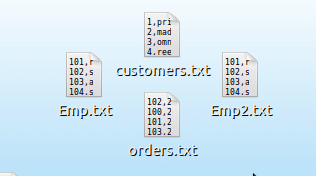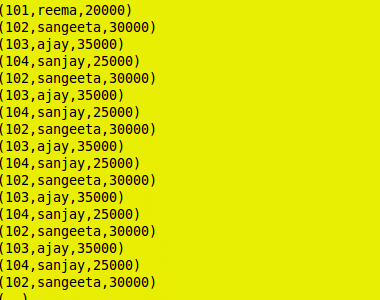PIG COMMANDS WITH EXAMPLES-PART -1
PIG COMMANDS WITH EXAMPLES-PART -1
create Four files
With name of Emp.txt,Emp2.txt,customer.txt,and orders.txt
Emp.txt file Data:
101,reema,20000
102,sangeeta,30000
103,ajay,35000
104,sanjay,25000
105,vijay,28000
106,abhay,22000
Emp2.txt files Data:
101,reema,20000
102,sangeeta,30000
103,ajay,35000
104,sanjay,25000
102,sangeeta,30000
103,ajay,35000
104,sanjay,25000
102,sangeeta,30000
103,ajay,35000
104,sanjay,25000
102,sangeeta,30000
103,ajay,35000
104,sanjay,25000
102,sangeeta,30000
103,ajay,35000
104,sanjay,25000
102,sangeeta,30000
customers.txt files Data:
1,priya,32,Ahmedabad,2000.00
2,madhulata,25,Delhi,1500.00
3,omnath,23,Kota,2000.00
4,reeja,25,Mumbai,6500.00
5,rahul,27,Bhopal,8500.00
6,kushagra,22,MP,4500.00
7,tania,24,Indore,10000.00
orders.txt files Data:
102,2009-10-08 00:00:00,3,3000
100,2009-10-08 00:00:00,3,1500
101,2009-11-20 00:00:00,2,1560
103,2008-05-20 00:00:00,4,2060
Copying files from local file system to hdfs(hadoop).
Load data from a file into a relation. Uses the PigStorage load function as default unless specified otherwise with the USING option. The data can be given a schema using the AS option
Display output of Emp:
UNION combines multiple relations together
grunt> Emp_Uni = UNION Emp, Emp2;
whereas SPLIT partitions a relation into multiple ones
grunt> SPLIT Emp INTO Emp11 if salary<30000, Emp12 if (20000<salary and 25000<salary);
Display Output of Emp11
Display Output of Emp12
The FILTER operator alone trims a relation down to only tuples that pass a certain test n
grunt> Emp_filter = FILTER Emp BY id == 103;
Display output of Filter:
grunt> DUMP Emp_filter;









